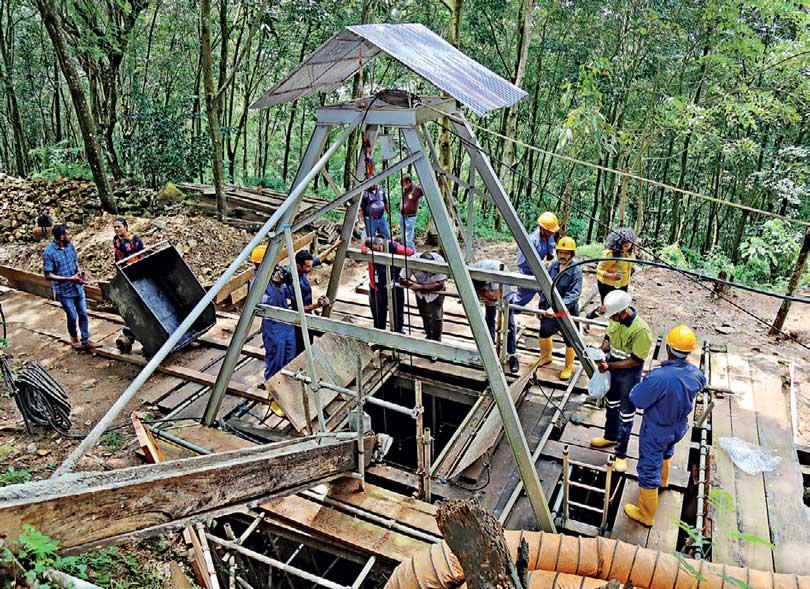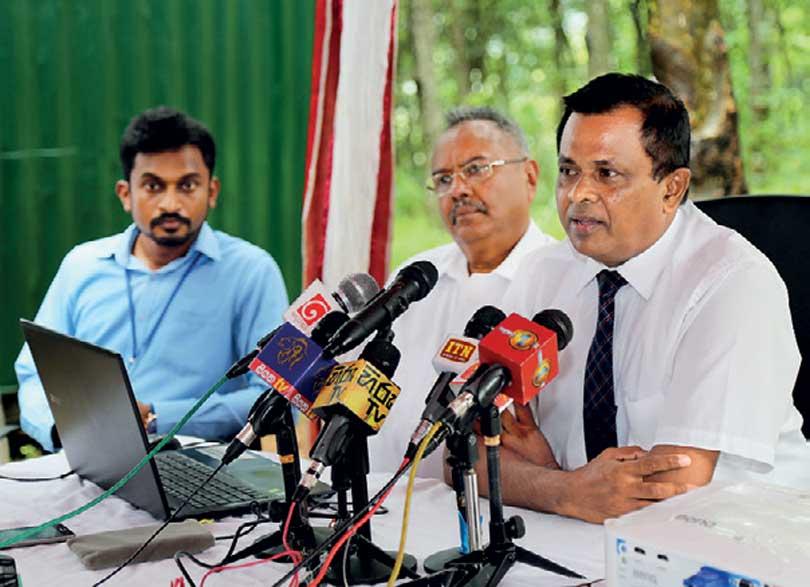27 Sep 2019 - {{hitsCtrl.values.hits}}

Karasnagala, the Sri Lanka’s third largest licensed mine after the Second World War launched its mining work on Thursday, September 19 at the Galigamuwa Divisional Secretariat in Kegalle District under the patronage of Chairman of the Geological Survey and Mines Bureau (GSMB) Asela Iddawela and other senior officials.
The Sarcon Development (Pvt) that obtained the mining license for Karasnagala mine entered into an agreement with the Board of Investment (BOI) in October 2012 to conduct a geological survey for graphite exploration.
However, the company was granted the IML Category - A license last August that gives exclusive rights to explore for mine, process and trade in all minerals mined within
the area specified.
This project was assisted by Geological Survey and Mines Bureau (GSMB) and the GSMB Technical Services Pvt Ltd that conducted a geological survey for
graphite exploration.
So far around USD 3 million has been spent on the project and the total investment Ceylon Graphite Corp expect to bring down is USD 500mn.
According to GSMB seven percent as royalties would be charged by the government for the extracted graphite once the survey to value addition
is completed.
The Environmental Impact Assessment (EIA) for the mine had been conducted by the GSMB Technical Services Pvt Ltd upon a request made by the company and the mining license has been obtained for a period of one year which is extendable up to 10 years.
According to exploration conducted, 53,000 tons of graphite deposit has been identified and mining to be conducted up to 155ft. initially.
The Karasnagala mine in Urapola is considered as the third mine that obtained the mining license from the Geological Survey and Mines Bureau (GSMB) after the World War II. Pandeniya mine in Warakapola and Meegahatenna mine in Aluketiya are the country’s first two mines that received the mining
license after the World War II.

It is also the largest graphite mine in Sri Lanka after the Kahatagaha mine and Bogala mine.
However, the Karasnagala mine had been used since the beginning of the World War II to extract graphite using human labour, considering the high demand for graphite based products. The mine
then referred as “Gal Pathala”.
Later the Karasnagala mine has been abandoned due to breathing issues suffered by labourers resulted by water leakage. Low technology and incompetent tools they had during the period believed to be another reason that caused to abandon the mine.
Speaking to the media, GSMB Chairman Asela Iddawela said that his office expects to boost the country’s economy via unearthing valuable minerals using sustainable methods. He further said that under the said project more employment opportunities will be generated and it would be a huge strength to the
rural development.
Expressing his views, Ceylon Graphite Corp Chairman, Bharat Parashar said that Sri Lanka is prosperous with great natural resources. “Sri Lanka has great natural resources here. Graphite will be one of key natural resource in the future. I think by 2020 we are going to have the demand for graphite globally.
Sri Lanka has the purest graphite of the planet. We don’t have all the facilities in the world yet. But we hope to implement a factory here according to international standards. Also, we are highly concerned about the environment and we do all our work here eco-friendly. De-carbonization is taking place and everybody is moving to alternative energy
(renewable energy).
But it is a big issue that energy storage. I’m confident that in future every house will have some sort of battery. So graphite is a key part of any battery in today’s technology. There are two parts in a battery, anode and cathode. Anode includes 60 percent of graphite. Cathode also includes some graphite. So our first main focus will be towards energy storage”.
According to Senior Director (Geology) Udaya De Silva, Karasnagala is a dry mine and graphite in this mine consist of a high carbon percentage over 97%.
The mine includes four vertical graphite veins and the entire project has been allocated 27 grids which spread through a 4.5 acre land.
The GSMB expects to extract graphite on a large scale from Karasnagala mine similar to Bogala and Kahatagaha mines.
Sri Lanka has great natural resources here. Graphite will be one of key natural resource in the future. I think by 2020 we are going to have the demand for graphite globally
19 Nov 2024 4 hours ago
19 Nov 2024 4 hours ago
19 Nov 2024 6 hours ago
19 Nov 2024 8 hours ago
19 Nov 2024 8 hours ago